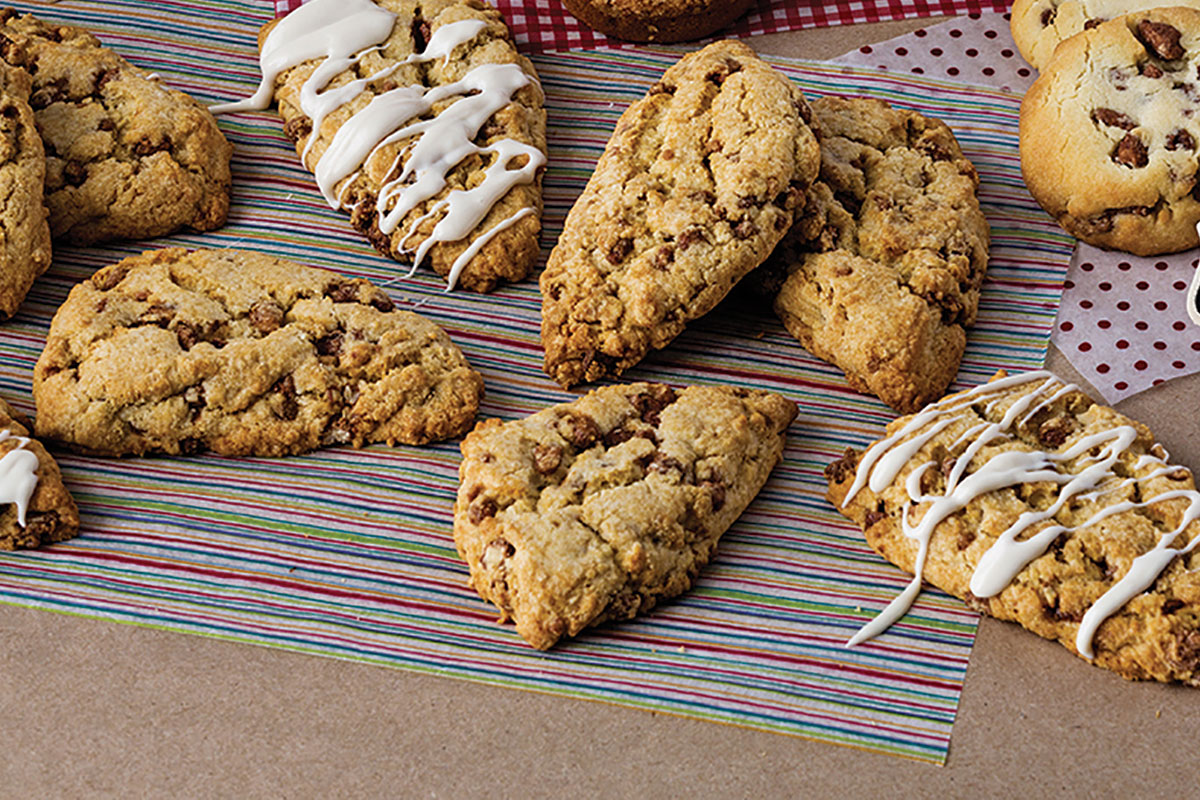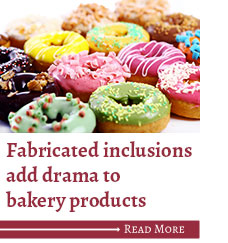Crunchy or gooey. Bright or bold. Sweet or salty. These are some of the many roles inclusions perform in baked foods when those little extras get folded into batters, layered between dough or sprinkled atop a donut.
Real pieces of chocolate, fruits and nuts are common add-ins to baked foods intended for fresh consumption. But products that get packaged and sold through food service and retail stores often require value-added inclusions such as fabricated flavorful bits, chips, chunks, crunches, fillings, flakes, nuggets and sprinkles. These ingredients are designed to withstand the rigors of baking and shipping. They may be colored, fortified and texturized, and through careful manipulation of formulation, suppliers control their performance in the finished products.
Two acts and an encore
The first act takes place at the bakery. Formulators must consider at what point in the process inclusions are added and how they will react to the environment.
“An inclusion being put into a batter that is going to sit for 30 minutes with several agitation cycles before being pumped to the depositor would require a lot more resilience and durability than one that is added just prior to depositing,” said Dennis Reid, vice-president of business development, Inclusion Technologies. “Bakers must keep in mind that inclusions are not a one-size-fits-all type of ingredient, and customization is usually required to optimize the performance in each specific end-use application and with each process.”

The second act happens during distribution.
“If the final product is a pre-packaged baked muffin sold at a convenience store for on-the-go snacking, then a strawberry-flavored bit inclusion would be more feasible than real strawberry fruit pieces,” said Paula Simons, product developer, Pecan Deluxe Candy Co. “This type of product must be formulated to have a longer shelf life than a muffin that is meant to be baked and consumed in the same day. Using real fruit pieces in this application could lead to mold and other unwanted bacteria growth and significantly reduce the ambient shelf life of the product, which is critical in this particular case.”
The encore — the final performance before purchase — is when shoppers eat with their eyes. Fabricated inclusions provide an economical and easy way to bake limited-time offerings, thereby creating an urgency to purchase. Their intent is to wow the consumer with flavor, texture and visual appeal.
“Today’s consumers want personalized experiences with their food,” said Jamie Wilson, director, business development, marketing, culinary, and research and development, Parker Products. “They are seeking intriguing experiences, including surprising textures and exotic flavors.”
Martin Ruiz, research chef at Parker Products, added that inclusions are a great way to entice consumers into purchasing a premium offering, but the decision to add inclusions to various formulations should still be a strategic one.
“A baker needs to ask all the right questions,” he said.
The audition
There are many variables for bakers to consider when working with fabricated inclusions. One of the reasons for choosing them over whole food ingredients is their ability to perform according to script.
“Flavor, texture, visual identity, melt point and food allergens are details that need to be at the forefront of ideation,” said Jerome Davis, technical solutions analyst, Innovative Bakery Resources. Responsible and sustainable manufacturing of the inclusions are also very important considerations. Mr. Davis said formulators need to address temperature abuse, moisture migration, staling, oxidation and color bleeding, among others during product development.
“We use many types of inclusions in our breakfast bread formulations and frequently work with the manufacturer to develop specific characteristics to achieve desired results,” he said.
For some applications, fat-based inclusions should have a precise melt point in order that they soften at a certain time in processing.
“This gives a unique look and texture in the finished product,” Mr. Davis added. “In some applications, it’s desirable for the inclusions to melt early in processing to give a marbled effect. In others, we want the inclusions to maintain structure for better flavor impact and reduced processing inconsistencies.”
Cereal-based and extruded inclusions should typically maintain their identity in processing to complement other additions such as dried fruit or whole grains.

Ms. Wilson pointed out that performance is the most important consideration. If it does not look appealing, the baked food will likely never be tasted.
“Are you adding bursts of butterscotch into a chewy cookie or a scattering of honey cinnamon sprinkles on top of a warm muffin?” Ms. Wilson said. “You’ll need a stable inclusion that can withstand the high-heat baking process for the former where you have more leeway with a topping that’s added after a treat is out of the oven. Regardless of the stage in the baking process, moisture must be a top consideration with both the application and the inclusion.”
In a dry bakery mix, for example, moisture migration from inclusions into the mix can cause clumping and impair the leavening agent. In a moist cookie, the vibrant pink color of sprinkles may bleed after absorbing moisture.
Moisture barriers may assist. They coat the inclusion and prevent moisture from going in and out.
“They help graham cracker pieces stay crunchy, brownie bites stay chewy and colorful sugars stay bold,” Ms. Wilson said. “Chipotle-glazed granola bits take an everything bagel to a new level with a spicy twist.”
Barriers also may preserve the integrity of the application by preventing staling and oxidation. In some instances, barriers function as a lacquer to preserve integrity of the inclusion.
Pecan Deluxe offers a cinnamon streusel topping for a baked pastry that requires a longer ambient shelf life. It’s durable enough to be merchandised in a vending machine.
“This cinnamon-flavored and -colored sprinkle provides a similar appearance and feel on the top of the pastry but has a more intense flavor profile, crunch and shelf life than a typical baked streusel topping,” Ms. Simons said. “Another option is praline nut meats. Compared with using raw nuts in baked applications, the praline nut meats are sweeter and maintain better crunch. They can also be customized to have different seasonings or flavor notes.”
Flavorful finale
Connecting with your audience is critical, and staying up with current pop culture is a strong strategy. Balchem Ingredient Solutions showcased a number of new inclusion flavors in cookies at this year’s Institute of Food Technologists (IFT)’s annual food expo.
“Inspired by the cakes served at the royal wedding and the next-to-nature trend, our royal wedding cookie is brightened by the subtle flavor of elderflower and the bright tartness of lemon together in one inclusion,” said Tracy Snider, marketing manager, Balchem. “The fragrant aroma of elderflower combined with lemon is a classic flavor combination that pairs well in delectably sweet baked goods.”
 Building on the booming mocktail trend, the company developed an inclusion flavored like the classic whiskey-based Old Fashioned libation.
Building on the booming mocktail trend, the company developed an inclusion flavored like the classic whiskey-based Old Fashioned libation.
“The only thing missing in this cookie is the Kentucky hug,” Ms. Snider said. “The essence of the cocktail comes through perfectly in our Old Fashioned inclusion.”
Another trending concept is cold-brew coffee, which is the beverage prepared without heat. This results in a naturally less acidic, somewhat sweeter flavor profile. Balchem now offers cold-brew inclusions that can be used in everything from brownie bites to energy bars.
Parker Products offers a range of bake-stable inclusions, including hard and soft candies.
“The hard-candy inclusions retain piece identity and can be developed with any flavor or color,” Mr. Ruiz said. “Some popular options include red and green mint, toffee, and maple. Our soft bake-stable options provide a stronger flavor delivery than hard candies due to their texture, which allows for more flavor to be incorporated in the formula. Fun and popular flavors that we currently offer include jalapeño cheddar, multi-colored and carrot cake.”
The sky is the limit for these functional delivery systems. Fabricated inclusions are an easy way to add quick innovation and variety to baked foods and attract the spotlight.





